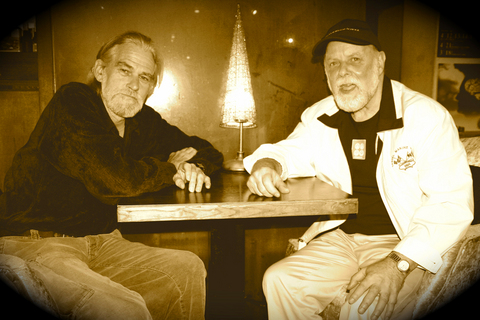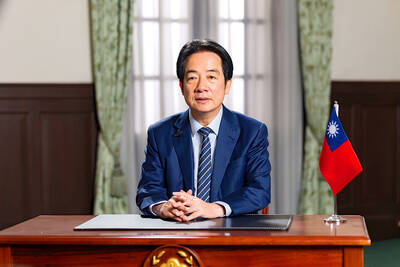He called it a "sentimental journey" returning to Taiwan after 40 years but Klaus-Peter Metzke was grumpy. The business consultant was tired from lugging around his suitcases, his flight to Germany would take off in a couple of hours and the heat and humidity was getting to him.
"Come on Peter, sort yourself out," said his friend Lynn Miles, a long-term expat and activist, as we settled down in the Shida coffee shop, Taipei. The 63-year-olds ordered cold beers and we started our trip down Memory Lane.
We went back to 1967 and a place where Generalissimo Chiang Kai-shek (蔣介石) ruled the country with an iron fist and martial law was imposed for the longest period in modern history (1949 to 1987). Freedom of assembly and the formation of political parties were curtailed, free speech and the press were curbed.

PHOTO: JULES QUARTLY, TAIPEI TIMES
An average taxi fare was about NT$6, pedicabs were NT$4, a month's rent was NT$400 and living expenses were about the same. America had an army base in the city and the few cafes that existed had strip lighting and played classical music.
After meeting on the streets of Shida, by chance, Metzke and Miles opened a cafe named The Barbarian (野人咖啡室), which helped transform the cultural landscape of Taipei by providing a place for intellectuals and artists to sit around with a good cup of coffee and listen to records.
Brother Hotel owner, Hung Teng-sheng (洪騰勝) backed the enterprise financially, but even so the basement coffee shop in Wumei Street, Ximending, was a "hole." It had seven tables and seating for just 15 people. The furnishings were homemade and the biggest draw was the music. There was nowhere else in town to listen to jazz, rock and the blues.
"It was a small, cramped hole. Once you were down it was like a trap and it was hard to get out. It was unlike anything else in Taipei at the time," Metzke said.
"It doesn't seem that special to open up a coffee shop now, it's normal, but 40 years ago it was something new, like opening a window. It was a place to meet and exchange ideas" at a time when people were discouraged from doing so, Miles said.
Lin Huai-min (林懷民), of Cloud Gate fame, is said to have written one of his books there. Pai Hsien-yong (白先勇) wrote a story in which The Barbarian featured. Native Literature Movement writer Li Ao (李敖) was also a visitor. The painter Shiy De-jinn (席德進) frequently dropped by and there were small art exhibitions.
Foreign students and journalists also hung out and according to Metzke, "It was the only place you could find these kind of people. The artists would come and do their own thing. They would read a poem, show off their works, even play the flute.
"There were so many big personalities, I still have their name cards. There was a deaf mute lady artist who was good at designing things and we also worked with Atayal Aboriginals on a weaving project.
"Taiwanese did not really travel abroad a lot at that time and if they did it was to emigrate and they did not come back. That was why so many people came to our coffee shop, it was an opportunity to learn a little about the outside world," Metzke said.
The German and the American arrived in Taiwan in the late 1960s.
Metzke described himself as a "Renaissance Man," with an interest in Chinese art and republishing academic books. He made a living by selling reprints from the National Palace Museum and helped out at the former Goethe-Institute in Taiwan (now the German Cultural Center).
Miles said he was "a retired student" (of Chinese) and was dodging the draft, though he later went to Vietnam as a war contractor. He was also an agitator for democracy and was expelled from Taiwan and not removed from the blacklist until 1996.
Metzke was responsible for the coffee and design of the cafe. Miles made lamps and tried putting burlap on the walls.
"That was a disaster, afterward we tried painting instead, but kinda went nuts because of the beer and vapors. We ended up rolling around the floor," Miles said.
They bought a stereo system and deejayed, introducing US artists like Bob Dylan, Jefferson Airplane, Mississippi John Hurt, Joan Baez and Miles Davis.
The Barbarian opened in September 1967 but Metzke and Miles moved on soon after, leaving Hong to run the coffee shop on his own. It survived until Spring 1970 and sadly closed because it was more trouble than it was worth. Some customers would nurse a cup of coffee all night long and refuse to leave at closing time.
"Apparently [Hong] had to call the cops to get people to leave and he wasn't making any money. There were rumors about a suicide but it was never confirmed," Miles said.
"We wanted to open a place where people could meet and exchange ideas but we weren't interested in running a coffee shop," Metzke said. "To be successful you need to contribute something new, something special at the right time. We did, but that time is finished, it's over."
As for today's Taipei, Metzke was impressed. He said there had been "enormous" development and attitudes had changed.
"People seem to have a broad way of thinking, it is very international. Taiwanese have not only been brave they have been successful. They did not have vision before but now it's a free country.
"These are not empty words. It is not like it used to be, when there was always pressure because of martial law. Before it was just a few artists and intellectuals who said what they thought. Now everyone can do it."

This month the government ordered a one-year block of Xiaohongshu (小紅書) or Rednote, a Chinese social media platform with more than 3 million users in Taiwan. The government pointed to widespread fraud activity on the platform, along with cybersecurity failures. Officials said that they had reached out to the company and asked it to change. However, they received no response. The pro-China parties, the Chinese Nationalist Party (KMT) and Taiwan People’s Party (TPP), immediately swung into action, denouncing the ban as an attack on free speech. This “free speech” claim was then echoed by the People’s Republic of China (PRC),

Most heroes are remembered for the battles they fought. Taiwan’s Black Bat Squadron is remembered for flying into Chinese airspace 838 times between 1953 and 1967, and for the 148 men whose sacrifice bought the intelligence that kept Taiwan secure. Two-thirds of the squadron died carrying out missions most people wouldn’t learn about for another 40 years. The squadron lost 15 aircraft and 148 crew members over those 14 years, making it the deadliest unit in Taiwan’s military history by casualty rate. They flew at night, often at low altitudes, straight into some of the most heavily defended airspace in Asia.

Many people in Taiwan first learned about universal basic income (UBI) — the idea that the government should provide regular, no-strings-attached payments to each citizen — in 2019. While seeking the Democratic nomination for the 2020 US presidential election, Andrew Yang, a politician of Taiwanese descent, said that, if elected, he’d institute a UBI of US$1,000 per month to “get the economic boot off of people’s throats, allowing them to lift their heads up, breathe, and get excited for the future.” His campaign petered out, but the concept of UBI hasn’t gone away. Throughout the industrialized world, there are fears that

The Democratic Progressive Party (DPP) controlled Executive Yuan (often called the Cabinet) finally fired back at the opposition-controlled Legislative Yuan in their ongoing struggle for control. The opposition Chinese Nationalist Party (KMT) and Taiwan People’s Party (TPP) acted surprised and outraged, but they should have seen it coming. Taiwan is now in a full-blown constitutional crisis. There are still peaceful ways out of this conflict, but with the KMT and TPP leadership in the hands of hardliners and the DPP having lost all patience, there is an alarming chance things could spiral out of control, threatening Taiwan’s democracy. This is no